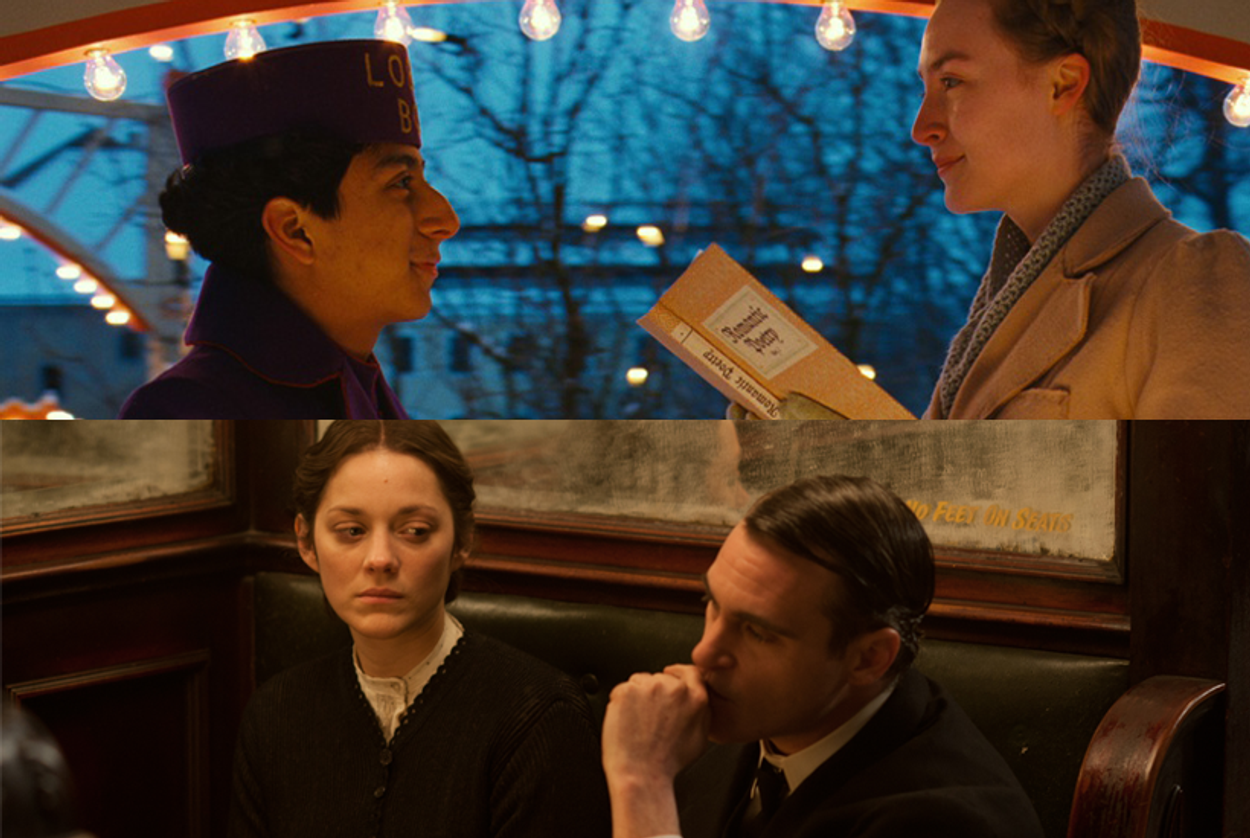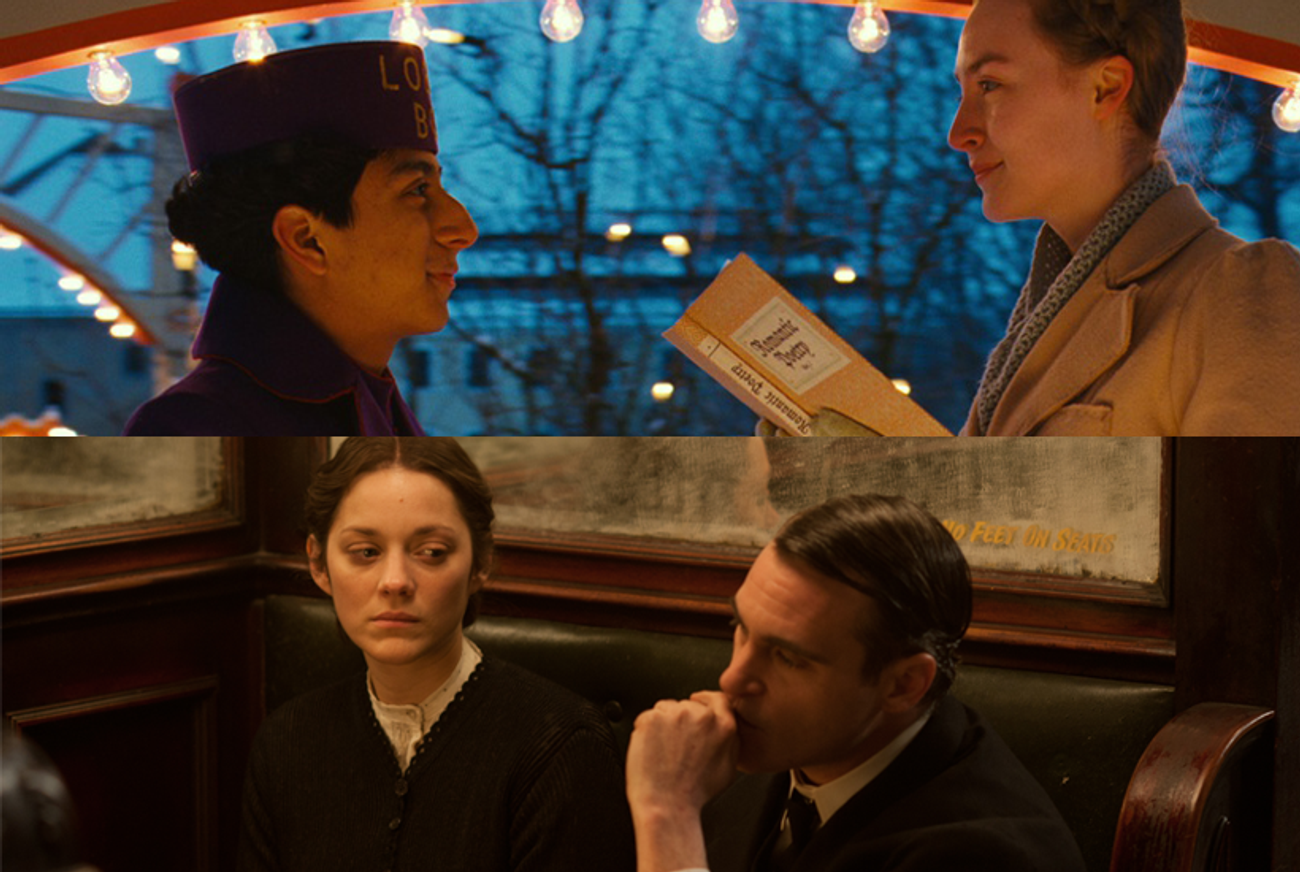Jewish-Themed Movies, Without Jews
Wes Anderson’s ‘The Grand Budapest Hotel’ and James Gray’s ‘The Immigrant’: period fantasies that shy away from real Jews




“The Jew is the one whom other men consider a Jew,” according to Jean-Paul Sartre’s existential reasoning. Thus anti-Semitism can exist without Jews. So can philo-Semitism, and so can the nebulous category known as Jewish-themed films. Take for example Wes Anderson’s The Grand Budapest Hotel and James Gray’s The Immigrant. These films may lack the essential pintele yid, but that doesn’t make them any less Jew-ish.
These two original and ambitious American movies released this spring are both set in vanished multiethnic, early-20th-century milieus, namely the former Austro-Hungarian Empire and the old Lower East Side. The echt Hapsburg novelist Gregor von Rezzori’s description of the Bucovinean city where he was born as home to “a dozen of the most disparate nationalities and at least half a dozen bitterly feuding faiths—all living in the cynical harmony that is built on mutual aversion and common business dealings,” could describe either.
As befits explorations of places the no longer extant, both movies take pains to project detailed, fully realized worlds. The Immigrant is grounded in a naturalistic, if digitally sweetened, 1921 New York, while the more obviously hyper-designed and seemingly wistful Grand Budapest Hotel evokes a fanciful mitteleuropa. Each is a lovingly crafted and fastidious triumph of mise-en-scène—narrative is subsumed by a powerful desire to revisit a specific time and place. The Immigrant’s phantom director is Frank Borzage, whose silent slum dramas include the original Lower East Side melting pot movie Humoresque; The Grand Budapest Hotel is haunted by the benign shade of Ernst Lubitsch, the most worldly and fanciful of Jewish Hollywood’s filmmakers.
Although The Immigrant and The Grand Budapest Hotel project an Old Country nostalgia that Jews might feel, while acknowledging a sense of transience or displacement that Jews could remember, Jewish subjectivity is displaced. The Immigrant has its designated Jewish characters (the cops call them “kikes”), a category that does not include the title character, who is forced into prostitution, as many Jewish women were, on the Lower East Side. The Grand Budapest Hotel has a protagonist who seems far too established to be Jewish and yet in his rootless cosmopolitanism might well be a crypto-Jew—the movie, according to Anderson, was inspired by the writings of the best-selling Austrian-Jewish author Stefan Zweig, who committed suicide in exile.
Zweig titled his 1943 memoir The World of Yesterday; The Immigrant is set in Irving Howe’s World of Our Fathers. The golden land where the Polish immigrant Ewa (Marion Cotillard) arrives, along with her tubercular sister, is policed by corrupt Irish cops and inhabited by mercenary half-Americanized Jews. Anderson’s protagonist, Monsieur Gustave (Ralph Fiennes), is the concierge and spirit of the Grand Budapest Hotel, an “enchanting old ruin” that is a drolly idealized version of the civilized Europe, the immigrants left behind.
With telegraphed villains and a suffering, persecuted heroine, The Immigrant can be readily imagined as silent movie—a version of Universal’s 1913 blockbuster Traffic in Souls. The fall of the film’s heroine is orchestrated by Bruno Weiss (Joaquin Phoenix), a smooth promoter and part-time pimp—as well as a fellow immigrant who has shed his overt ethnicity and adapted to the prevailing system. After a struggle, Ewa allows Bruno to turn her out in order to raise money to get her quarantined sister off Ellis Island.
On one fruitless return to the Island of Tears, Ewa joins an audience being entertained by Orlando the Great (Jeremy Renner), a stage magician who turns out to be Bruno’s cousin. Orlando’s illusions give The Immigrant a touch of magic realism. There are also intimations of Fellini’s La Strada in the fatal competition that develops between Bruno and Orlando for possession of the heroine—two nominally Jewish boys fighting over the Poylishe shikse who, several times identified with the Statue of Liberty, is something like the promise of America. Postmodern in his use of silent movie melodrama, Gray is aware of the Lower East Side’s popular culture, paying particular interest to primitive burlesque and other Bowery entertainments: A poster of conjoined twins Violet and Daisy Hilton is strategically placed in one saloon; Enrico Caruso actually did perform at Ellis Island as shown here; it’s possible that, like the fictitious Orlando, the real Harry Houdini did as well. (One of his most famous escapes was staged in New York harbor.) In any case, it hardly seems coincidental that Orlando’s actual moniker Emil Weiss echoes Houdini’s Jewish birth name, Erik Weisz.
Ewa may be The Immigrant’s protagonist, as well as its most historically significant figure, but she is emphatically not a Jew—something that renders her more universal and also more singular. At the turn of the 20th century, Allen Street, a boulevard running beneath an elevated train through the center of New York’s Jewish ghetto, was the city’s preeminent red-light district, and the neighborhood itself was a center of what was euphemistically known as the white-slave trade. Jewish prostitutes were mainly foreign born and locally recruited by Jewish “cadets.” (See Mike Gold’s autobiographical novel Jews Without Money for an unvarnished description of Harry the Pimp and his whores, characterized as hapless peasants drafted into a war: “They lived in the slime and horror of the trenches, knowing why as little as soldiers.”)
Moreover, The Immigrant’s key themes—martyrdom, sin, redemption, and forgiveness—are amplified by making Ewa a devout Catholic, and her ethnicity usefully complicates the movie’s romantic equation. While Ewa never refers to Bruno as a Jew, the evident physical revulsion he inspires in her suggests something more than personal antipathy. It’s never clear if the pimp ever rapes her or otherwise avails himself of her favors, adding another element of tension to their relationship and the filmmaker’s attitude toward his material.
Prostitution was a subject for popular Yiddish theater throughout the 1910s, particularly after the succès de scandale of Sholem Asch’s shocker God of Vengeance, a play set in a brothel run by an ostensibly pious Jew. That the “other” language in The Immigrant is not Yiddish but Polish is striking, in that Gray’s previous films—the gangster films Little Odessa and We Own the Night, and the romantic drama Two Lovers—have struggled, with mixed results, to portray Jewish characters on the mean streets of Russian-Jewish Brighton Beach.
Gray has linked these movies, along with The Immigrant, to his own background. In his public appearances, the filmmaker enjoys playing a Woody Allen type—ironically self-deprecating, playfully neurotic, pleased to launch into a heavy Yiddish accent. No such character exists in The Immigrant, where the Jews are notably un-Jewish.
The Grand Budapest Hotel, on the other hand, is a movie that Woody Allen might well wish he had made. Exhuming what von Rezzori called “the glory of the sunken Austro-Hungarian Empire,” shot half in the studio and entirely in Germany, Anderson’s film is a fabulous pastiche. The film quotes works as varied as Hitchcock’s Torn Curtain and Polanski’s Fearless Vampire Killers; the score, composed by Alexandre Desplat, combines Russian balalaikas and cimbalom-driven Romanian czardas. The props seem to have been assembled in Santa’s toy shop; the snowy vistas suggest a window display at FAO Schwarz.
This period piece opens with a typically mixed message—the sound of carefree Tyrolean yodeling in what might be a venerable Prague graveyard. Framed as a story within a story within a story, jumping backward from the mid 1980s to the late ’60s to 1932, each period represented by a different aspect ratio, the narrative is set mainly in the fantasy Republic of Zubrowka (named for a Polish vodka) in and around the eponymous establishment, an imaginary hilltop confection partially inspired by the Grandhotel Pupp in the Czech spa city Karlovy Vary.
The use of a hotel or sanitarium as a metaphor for Central Europe is a venerable tradition: Thomas Mann’s The Magic Mountain may be the greatest example, but Bohumil Hrabal’s I Served the King of England and Joseph Roth’s Hotel Savoy are also notable. Vicki Baum, like Roth and Zweig a German-speaking Jew, invented many of the clichés with her Grand Hotel (the source of innumerable ’30s movies); the Hotel Occidental in Kafka’s Amerika is suspiciously mitteleuropean, and even Sholem Aleichem wrote an epistolary novel, Marienbad, about Polish Jewish alrightniks swanning around a Czech spa that, as one writes to his wife in Warsaw, has “gone downhill since the British King Edward died several years ago.”
The Grand Budapest also has its erotic intrigues. M. Gustave is impeccably correct and bizarrely louche—a stickler for order, a bit of a gigolo, and a stylized self-made man, whose enemies consider him a parvenu. There’s a touch of Groucho in Gustave’s loping run, attraction to rich dowagers, and arch one-liners, and something of Stefan Zweig in his groomed mustache, practiced bonhomie, and what Hannah Arendt, not a fan, termed the writer’s “hypersensitivity to social humiliation.” (Interestingly, Anderson has also cited Eichmann in Jerusalem as an influence on his film.)
There’s nothing in The Grand Budapest Hotel to suggest Gustav’s ethnic background, although his indifference to and ignorance of Catholic ritual is evident. Noticeable too is his reflexive use of the epithet “fascist”—the only time anyone in the movie employs the term. As perversely proper as he is, the concierge demonstrates an unexpected sympathy for his young protégée, the hotel boy Zero Moustafa, once he recognizes him as an orphaned, stateless refugee. (The lad’s Muslim name suggests that he comes from the Balkans or Caucasus, although he is also the sole survivor of a massacre recalling the Armenian genocide.)
Dark undercurrents notwithstanding, The Grand Budapest Hotel is mainly an antic adventure, with a priceless painting as a MacGuffin, that gets increasingly bloody—if no less amusing—as Zabrowka drifts ever closer to war and suffers something that strongly evokes Nazi occupation. Although lightly touched upon, Gustav’s fate is as doomed as his milieu. “His world had vanished long before he entered it,” the elderly Moustafa will recall, clinching the concierge’s identification with Zweig. Like The Immigrant, The Grand Budapest Hotel acknowledges, however obliquely, a particular Jewish tragedy.
I don’t fault the filmmakers for making the movies that they made. On the contrary. Still, I would like someday to see an acerbic fantasy along the lines of Roth’s Hotel Savoy focusing on the culture that Jews lost when the old empire disintegrated or a historical melodrama with the ferocity of Sholem Asch concerning lives of Jewish prostitutes in the slums of New York.
***
Like this article? Sign up for our Daily Digest to get Tablet Magazine’s new content in your inbox each morning.
J. Hoberman, the former longtime Village Voice film critic, is a monthly film columnist for Tablet Magazine. He is the author, co-author or editor of 12 books, including Bridge of Light: Yiddish Film Between Two Worlds and, with Jeffrey Shandler, Entertaining America: Jews, Movies, and Broadcasting.
J. Hoberman was the longtime Village Voice film critic. He is the author, co-author, or editor of 12 books, including Bridge of Light: Yiddish Film Between Two Worlds and, with Jeffrey Shandler, Entertaining America: Jews, Movies, and Broadcasting.